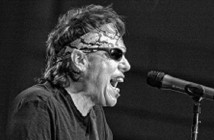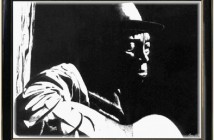Aficionados, of any variety, can quickly recall the moment when they were first smitten. Whether its cigars, cars, or cameras, we can all have stories of when and how we got hooked.
Blues lovers know what I mean. For me, it was The Blues Brothers, the 1980 classic film comedy set in Chicago. The soundtrack is not hardcore blues. It’s more rhythm and less blues. Belushi and Ackroid jump around and dance a lot with legends of big band and soul music, but despite the movie’s title, they are not really bluesmen although they had the big band legend Cab Calloway as a father figure and James Brown as a preacher in the movie.
There is one glorious scene that appropriately takes place in the Maxwell Street Market, the place where the Chicago-style electric blues were first developed. Out of nowhere comes,Boom boom boom boom! John Lee Hooker is cracking out one of his greatest songs. That was when the hairs on my neck stood up. From that point on I could actually feel the blues.
John Lee turned on the gas, and I started simmering. I got my hands on some records and started listen to college radio blues programs. I felt as if I had personally discovered Muddy Waters, Howl’n Wolf, Willie Dixon, Elmore James, and James Cotton. These guys, and their bands, guided me to Chess Records.
I got mad at my friends who loved the Grateful Dead’s version of Turn on Your Love Light, but didn’t know who Bobby “Blue” Bland was. I laughed when people told me that their favorite bluesman was Eric Clapton, who is more of a pop singer to me. I felt I had a good understanding of the blues and Chicago was its sweet home.
John Lee Hooker was the messenger who first showed me that the blues were inside me but it took years before I figured out just where he got the blues. I was lucky to meet somebody who knew much more about the blues than I did. We became good friends and would listen to each other’s music collections. He introduced me to the same bluesman who John Lee Hooker saw play on a Mississippi plantation when he was just a boy. The same man whom a teenaged Howl’n Wolf used to follow around and hope to get to tune his guitar. The same guy whose records Muddy Waters used to listen to in his shack a few towns away when he was learning how to play the blues. Maybe you are thinking Robert Johnson? No, the man who make fun of little Robert Johnson when he tried to sneak up on stage and play his harmonica.
I’m talking about the legendary Charley Patton.
There is a heap of research and theory about Charley Patton, but not that much is known about the man who some musicologists describe as one of the most important artists in 20th century American music. There is only one known photograph of him, wearing a slightly crooked bowtie. He was born in 1890, and lived his whole life in Mississippi. He made 92 recordings in the late 20s. In those days they sold for a dollar or so, now they go for up to $20,000 at auctions. The records were important because they were some of the first real Delta blues that were recorded and distributed. They were race records, made and marketed by a furniture company so they could sell more phonograph players to poor sharecroppers.
The recordings were originally not made to high standards, and since the masters were sold for scrap for the war effort in the 40s, you can now only hear copies of the 78s, which in many times are a bit scratchy and rough. Unless you hunt down the lyrics, sometimes it is tough to even understand what he is singing about.
One of my favorite songs is Tom Rushen Blues, [see link above] which Charley wrote in homage to the county’s sheriff, who had thrown him in jail a few times for being too drunk to stand. It includes the line: “It takes boozy booze, Lord, to cure these blues. Each day seems like years in the jailhouse where there ain’t no booze.” It also tells how Patton was saved by Rushen’s deputy, Mister Day, who slipped him some whiskey from a sleeping prisoner who had smuggled it in: “It were late one night, Halloway was gone to bed, Mister Day brought whiskey taken from under Halloway’s head.”
No boozy booze for me, but for a few years it was Riesling wine, from the Mosel region that cured my blues. The particular cooperative that produced the wines I really liked had a falcon as a brand mark on the foil that covered the cork. As a toast to Charley, I started making a collage, starting off with an illustration based on the only known photography of him. After each bottle, I cut out the falcon and glued it on to Patton. Perhaps the birds and the blues both symbolized the need to fly away for a while. With each flight, I pinned a medal on Charley, promoting him to General Patton. Like green stamps, my card got filled up, and I added some gold leaf to adorn the King of the Delta. Eventually, I had to stop before my booze labels consumed the man. [See image below at the end of the post.]
Just as 30 year-old Glenfiddich is wasted on a first time scotch drinker, Patton is a bit of an acquired taste. But as all aficionados know, to fully understand the brilliance of your obsession, it is the journey, not the destination that makes it all worthwhile.


